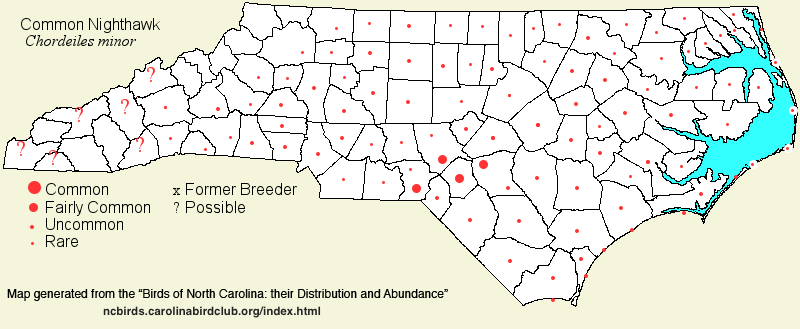 |  |
|
Common Nighthawk - Chordeiles minor CAPRIMULGIDAE Members: | Search Common: Search Scientific: |
|
|
|||||||
| General Comments | The Common Nighthawk has undergone a considerable decline as a breeding species in the eastern United States, for several reasons. The species often nested in cities and large towns on gravel rooftops; however, many businesses are now eliminating gravel from roofs because of various liability issues. And, despite many new malls and shopping centers being built, gravel roofs are not "in vogue". It is likely that predation of eggs and young on rooftops by crows, especially by the increasing Fish Crows (inland), is a major factor. (The nighthawks starting disappearing as city breeders within ten years after the arrival of Fish Crows in many Piedmont cites and towns, mostly in the 1970's into the early 1980's; this crow species is a voracious feeder on eggs and nestlings of other birds, and non-flocking rooftop nesting birds are easy prey targets.) In other areas, the birds are losing habitat to development or fire suppression, as the species most frequently nests on bare sand in scrubby areas. The fall migration through the mountains used to be a remarkable spectacle, with at times 500-1,000 birds being seen in a single evening; now, peak numbers are typically in the hundreds, at best. Nighthawks forage mostly near dusk and at night, well above the ground, most often over dry scrubby habitats, such as near the coast or in the Sandhills; however, they (mostly formerly) also feed over cities and can be seen at night chasing insects in lights at ball parks. The species completely departs the United States by mid-fall, though there are a few winter records of stragglers. (Winter reports need to be carefully scrutinized, as the Lesser Nighthawk is possible at that time of year.) | ||||||
| Breeding Status | Breeder | ||||||
| NC BRC List | Definitive | ||||||
| State Status | W | ||||||
| U.S. Status | |||||||
| State Rank | S3B | ||||||
| Global Rank | G5 | ||||||
| Coastal Plain | Breeder and migrant; declining. In the breeding season, variously uncommon to locally fairly common along and near the coast. Farther inland and in Tidewater, rare to uncommon, and found mainly in larger towns and cities, as well as in the Sandhills, where more numerous though still uncommon to fairly common. Very rare to rare in counties or areas without sizable towns (over 5,000 population). No obvious spring migration, but can be numerous at times in fall. Mainly late Apr to mid-Sep, sparingly to early Nov; a remarkable winter report of one heard calling at the UNC-Wilmington campus from 29 Nov 2003 to 3 Jan 2004. Another was noted at Fayetteville on 1 Dec 2004. Peak counts: 160, Carolina Beach, 12 Aug 1981; 105, Hoffman (Richmond), 24 Aug 1981; 65, Wilmington, 1 Sep 1987. | ||||||
| Piedmont | Breeder and migrant; strongly declining and becoming nearly extirpated as a nesting bird in the province. Formerly fairly common breeder, at least around larger towns and cities. Currently, now absent to locally rare around such sites, but presumably absent as a breeder in areas (including whole counties) without major towns/cities. Essentially all breeding appears to be at rooftops in the region. No obvious spring migration, but can be fairly common to occasionally common in fall in the foothills, but less numerous farther eastward. Mainly late Apr to mid-Sep, rarely to early Nov. One winter report, if correct -- one seen and heard near dusk over a Greensboro (Guilford) shopping center on 21 Feb 2025 [Chat 89:73 link]. Peak counts: 1,000, Winston-Salem, 2 Sep 1974; 852, Tryon area, 1 Sep 1987. | ||||||
| Mountains | Scarce breeder (if not now absent), and migrant; declining. In the nesting season, apparently restricted to cities and major towns in the southern mountains -- e.g., Asheville, Hendersonville, and Brevard; very rare breeder elsewhere, and apparently absent as a breeder in most mountain counties. Certainly absent as a breeder above 2,500 feet. Often common in early fall as a southbound migrant, peaking in the first few days of Sep, though numbers have declined in recent years. Mainly late Apr to late Sep. Peak counts: 1,000, Asheville, 3 Sep 2002; 500, Blue Ridge Parkway (Watauga), 5 Sep 1977; 500, Hendersonville, 6 Sep 1992. | ||||||
| Finding Tips |
You often must make some effort to see a nighthawk in the state. Normally, you will see them in very late afternoon, just before dusk. Formerly one could see them over cities in late spring and summer. Now (2025), they are best looked for in the Sandhills and in the southern coastal area, where they can be found high overhead late in the afternoon and near dusk, less so at dawn. They are most easily found in the mountains in late Aug and early Sep, by scanning the skies near dusk. ** to *** | ||||||
| Attribution | LeGrand[2025-05-07], LeGrand[2025-01-29], LeGrand[2023-03-03] | ||||||
| NC Map Map depicts all counties with a report (transient or resident) for the species. | Click on county for list of all known species. |
| NC Breeding Season Map Map depicts assumed breeding season abundance for the species. |  |